SFX
by Martin Willey
The use of miniatures to represent full-size objects dates to the early days of photography. Possibly the first model effects on film is the 1899 short film The Battle of Manila Bay by J. Stuart Blackton, featuring photographic cut-outs of ships in the bathtub, while his wife blew cigarette smoke over the scene. In 1902, Georges Méliès made Le Voyage dans la Lune, the first science fiction film with models. By the 1960s, Derek Meddings, with his assistant Brian Johnson, were making science fiction series for Gerry and Sylvia Anderson with a high proportion of model shots. But it was 2001: A Space Odyssey which set the standard for model effects, with Douglas Trumbull and Brian Johnson working on the models. Thanks to Star Wars, films until the 1990s were full of inventive spaceship models, but since the 2000s most spaceships are digital.
Models are often built in multiple scales. Models seen close to the camera must be detailed enough to withstand scrutiny. Models only seen in the distance can be smaller and cruder. The largest 44 inch Eagle was built in approximately 1:24 scale, although the actual scale is problematic, and the exteriors do not properly match the interior sets. Although Moonbase Alpha and most miniature sets were built in the studio, most of the models were built by external contractors, either Space Models or Martin Bower. See the Catacombs Model Guide.
While models can be detailed and "weathered" to look realistic, the scale can be obvious when photographed. The camera lens has a specific focus point, which is smaller at small distances like a model. The camera lens aperture can be made smaller, which creates a greater depth of field, but the set needs strong lights to compensate for the small aperture. Film speed is an issue here; a static shot may need a slower speed with long exposure per frame so the model is properly illuminated and in focus. Alternatively, a model in motion may need a faster speed to hide any jerkiness, but this may compromise lighting and focus.
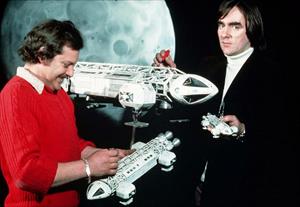
Nick Allder and Brian Johnson pose with the 3 scales of Eagle - 44 inch, 22 inch (held by Allder) and 11 inch (held by Johnson), in front of the Moon. more photos
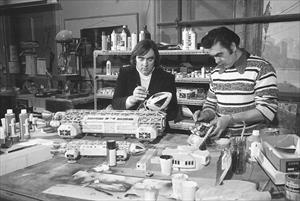
Brian Johnson and Cyril Forster with the 44 inch and 22 inch Eagles, plus two scales of moonbuggy and photo cut-outs. more photos
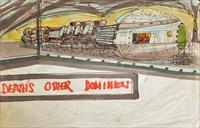
Spaceship designs were sketched by Brian Johnson or Martin Bower. See Bower sketches
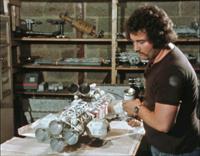
In the model room, Dave Watkins rigs up the Eagle engines using a freon gas canister. A few models were fitted with mechanisms, notably the freon gas canisters to simulate rockets in the Eagles for launching and landing, the engines of the Voyager, and the opening doors of Taybor's ship. There was even a remote controlled moonbuggy. More photos
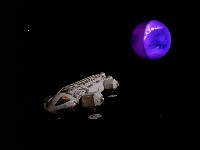
The Eagles command modules were hollow, with two figures from the Revell 1:24 scale Gemini kit as pilots, but these were never visible on screen. Occasionally a light bulb was illuminated inside.
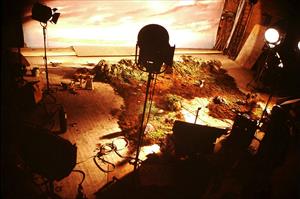
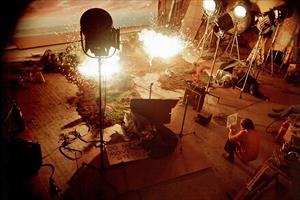
Miniature sets and explosions. Skies, like live action sets, were usually painted backdrops. More photos
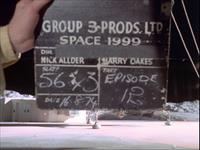
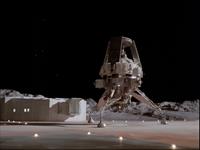
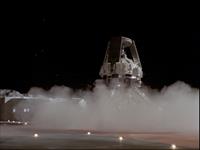
Filming the Voyager taking off, with freon engines. The background lunar mountains are flat photo cut-outs, making the launch pad a quick and small set to create. More photos
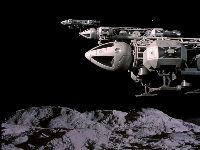
Breakaway. There were only 3 Eagle models during filming this episode. For this shot, all 3 (44 inch, 22 inch and 11 inch) appear alongside in a "forced perspective" shot. It looks like three Eagles of the same size.
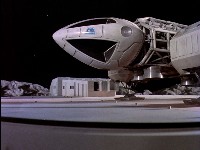
Another forced perspective shot from Matter Of Life And Death, positioning the 44 inch Eagle closer to camera. The launch pad is actually is scaled to the 22 inch Eagle. The camera angle makes it much more dramatic.
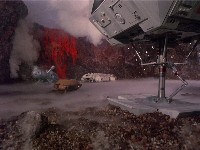
The Metamorph, a forced perspective shot with a special larger Eagle leg in the foreground.
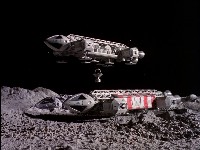
There was still only one 44 inch Eagle when filming this shot. The winch Eagle is the smaller 22 inch model, the red striped Eagle is the 44 inch model. The rear model is a photo cut-out. Other shots filmed the 44 inch Eagle twice, with multiple exposures.
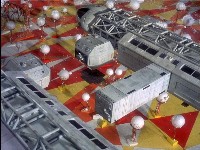
Guardian Of Piri, using careful framing, there is only one 44 inch Eagle in this shot. The foreground Eagle has a partial spine and the top half of a pod, with one of the leg pods from the other Eagle.
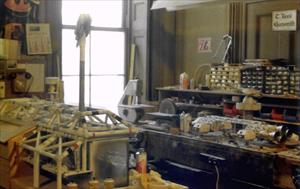
A partial large Eagle and the laser turret were made for close-ups.
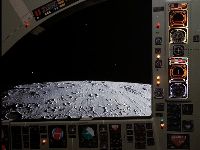
The Eagle interior window was itself a SFX prop (the "instruments" are photo cut-outs of real instruments from a Sperry aviation catalogue). The rolling lunar horizon seen here is a barrel-shaped moon which was rotated in front of the camera (more details).
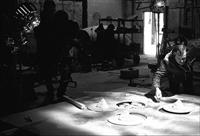
The barrel moon is in the background of this shot, against the wall. More photos
Copyright Martin Willey